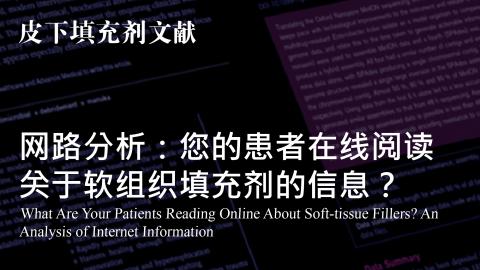
- 3531人
- 分享收藏
【皮下填充物文献】网路分析:您的患者在线阅读关于软组织填充剂的信息?
What Are Your Patients Reading Online About
简介
【 文献重点摘要 】
Background
Soft-tissue fillers are increasingly being used for noninvasive facial rejuvenation. They generally offer minimal downtime and reliable results. However, significant complications are reported and patients need to be aware of these as part of informed consent. The Internet serves as a vital resource to inform patients of the risks and benefits of this procedure.
Methods
Three independent reviewers performed a structured analysis of 65 Websites providing information on soft-tissue fillers. Validated instruments were used to analyze each site across multiple domains, including readability, accessibility, reliability, usability, quality, and accuracy. Associations between the endpoints and Website characteristics were assessed using linear regression and proportional odds modeling.
Results
The majority of Websites were physician private practice sites (36.9%) and authored by board-certified plastic surgeons or dermatologists (35.4%) or nonphysicians (27.7%). Sites had a mean Flesch-Kincaid grade level of 11.9 ± 2.6, which is well above the recommended average of 6 to 7 grade level. Physician private practice sites had the lowest scores across all domains with a notable lack of information on complications. Conversely, Websites of professional societies focused in plastic surgery and dermatology, as well as academic centers scored highest overall.
Conclusions
As the use of soft-tissue fillers is rising, patients should be guided toward appropriate sources of information such as Websites sponsored by professional societies. Medical professionals should be aware that patients may be accessing poor information online and strive to improve the overall quality of information available on soft-tissue fillers.
背景
软组织填充物越来越多地用于非侵入性面部年轻化。它们通常提供最短的停机时间和可靠的结果。然而,报告了严重的并发症,作为知情同意的一部分,患者需要意识到这些。互联网是告知患者这一过程的风险和益处的重要资源。
方法
三位独立的评价者对65个提供软组织填充物信息的网站进行了结构化分析。使用经过验证的工具跨多个域分析每个站点,包括可读性、可访问性、可靠性、可用性、质量和准确性。使用线性回归和比例优势模型来评估端点和网站特征之间的关联。
结果
大多数网站是医生私人执业网站(36.9%),由委员会认证的整形外科医生或皮肤科医生(35.4%)或非内科医生(27.7%)创建。站点的平均Flesch-Kincaid等级水平为11.9±2.6,远高于推荐的6-7等级水平。医生私人执业网站在所有领域得分最低,明显缺乏关于并发症的信息。相反,专注于整形外科和皮肤科的专业协会网站以及学术中心的整体得分最高。
结论
随着软组织填充物的使用增加,患者应该被引导到适当的信息来源,如由专业协会赞助的网站。医疗专业人员应该意识到,患者可能在网上获取不良信息,并努力提高软组织填充物信息的整体质量。



